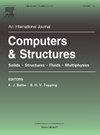面内荷载作用下砌体墙体协调应变上限分析模型
IF 4.4
2区 工程技术
Q1 COMPUTER SCIENCE, INTERDISCIPLINARY APPLICATIONS
引用次数: 0
摘要
我们提出了一种用于平面荷载砌体结构上限极限分析的新型数值模型。该模型由平面元素组成,其运动学结合了刚体速度和塑性应变率。全局速度场保持连续,裂缝配置通过塑性应变率进行描述。同质化确保了连续体塑性应变率场与异质材料运动学之间的兼容性:将砌体理想化为刚性砖块和摩擦零厚度接缝的组合体,关联流规则通过定义兼容塑性应变率域的同质化运动学关系来表达。推导出的极限分析问题被写成一个线性编程问题,得出承载能力的上限以及刚体速度和兼容塑性应变率域。最后,由塑性应变率 L2 准则控制的局部网格细化策略优化了机制表示。与传统的均质化极限分析方法相比,所提出的方法通过应变率而不是应力来定义失效域,提供了一种更紧凑、计算效率更高的数值方法。通过数值示例以及与成熟的分析和数值模型的比较,证明了该方法的有效性。本文章由计算机程序翻译,如有差异,请以英文原文为准。
Compatible strain-based upper bound limit analysis model for masonry walls under in-plane loading
We present a novel numerical model for the upper bound limit analysis of in-plane loaded masonry structures. The construction is represented as a continuum model composed of planar elements whose kinematics combines rigid body velocities and plastic strain rates. The global velocity field remains continuous and crack configurations are described via plastic strain rates. Homogenization ensures the compatibility between the continuum’s plastic strain rate field and the kinematics of the heterogeneous material: idealizing masonry as an assembly of rigid bricks and frictional zero-thickness joints, the associative flow rule is expressed through homogenized kinematic relations defining a domain of compatible plastic strain rates. The derived limit analysis problem is written as a linear programming problem, yielding an upper bound of the load-bearing capacity along with rigid body velocities and a compatible plastic strain rate field. Finally, a local mesh refinement strategy governed by the -norm of plastic strain rates optimizes the mechanism representation. The presented formulation offers advantages over the conventional homogenized limit analysis methods by defining a failure domain via strain rates, rather than stress, providing a more compact and computationally efficient numerical approach. Its efficacy is proven through numerical examples and comparisons with well-established analytical and numerical models.
求助全文
通过发布文献求助,成功后即可免费获取论文全文。
去求助
来源期刊

Computers & Structures
工程技术-工程:土木
CiteScore
8.80
自引率
6.40%
发文量
122
审稿时长
33 days
期刊介绍:
Computers & Structures publishes advances in the development and use of computational methods for the solution of problems in engineering and the sciences. The range of appropriate contributions is wide, and includes papers on establishing appropriate mathematical models and their numerical solution in all areas of mechanics. The journal also includes articles that present a substantial review of a field in the topics of the journal.
 求助内容:
求助内容: 应助结果提醒方式:
应助结果提醒方式:


